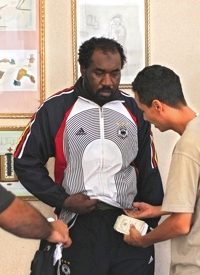
Media coverage of the NATO war in Libya has been marked by so much disinformation, lies, and deception that it is becoming hard to tell fact from fiction, with both sides engaging in what is termed “psychological operations” to confuse and demoralize their opponents.
Blatant examples of the strategy occurred in recent days as President Obama claimed the Libyan regime was finished even as Gadhafi and his sons vowed to continue fighting “for years” if necessary. Wildly conflicting accounts — often from reporters on the scene — make it almost impossible to tell what has really been going on in Tripoli this week.
“The Gadhafi regime is coming to an end, and the future of Libya is in the hands of its people,” Obama claimed in a televised speech on August 22. Two days later, the embattled Libyan ruler made a public statement vowing to fight and urging residents of the capital to “free Tripoli” from the “devils and traitors.”
A spokesman for the regime announced on August 24 that thousands of loyal soldiers were flooding into the city to drive out the rebels and their NATO backers. "We are able to fight, not for days or months, but for years,” he explained. “And we have put plans and alternative plans in this regards.”
Fighting continued to escalate, and by August 24, both sides were still claiming to control large swaths of Tripoli. Rebel fighters had reportedly overrun Gadhafi’s complex the day before, but the man who has ruled Libya for over four decades was supposedly nowhere to be found.
Despite relentless bombing from NATO, Gadhafi’s forces still controlled more than a few cities in the Western regions by Wednesday morning. But U.S. and European media outlets continued to paint a picture of a fully completed “regime change” mission.
One of the most astounding illustrations of the confusion — or deception — was the widely heralded claim that Gadhafi’s son Saif Al-Islam had been captured by the invading forces. The International Criminal Court (ICC) even “confirmed” the development.
The news spread around the world like wildfire, with countless media outlets reporting it as fact. It never actually happened.
That same night, Saif went to a hotel in Tripoli where foreign journalists have been staying. He rounded up a large group of reporters to “refute the lies,” even giving several interviews.
Then, surrounded by throngs of cheering supporters, the supposedly imprisoned son took the journalists on a tour of the capital. They eventually even went to Gadhafi’s compound — supposedly seized by rebels earlier that day, according to innumerable media accounts.
The events dealt a crushing blow to the credibility and morale of the NATO-backed forces on the ground. The ICC, which claimed it was already negotiating the transfer of Saif to the Hague, was also left with its tail between its legs. And the media, duped yet again, was reluctantly forced to concede that exposure of the fraud was damaging to the NATO cause.
But Gadhafi’s son seemed amused. "The West has high-tech technology which disrupted telecommunications systems and sent messages to the people," Saif told reporters, saying there was an information war going on. "This is a technological and media war to cause chaos and terror in Libya."
The rebels, meanwhile, blamed Gadhafi loyalists within their own ranks. "There was misinformation intentionally put out by fifth column people to discredit the [Interim Transitional National Council] and they were successful," rebel spokesman Shamsiddin Abdulmolah was quoted as saying by Reuters, which tried to minimize the embarrassment.
The confusion and distortion of reality in media coverage of Libya is hardly a new phenomenon, however. In fact, some observers claim it has been going on from the very beginning.
Earlier this year, reports of massacres by the Libyan regime prompted the United Nations resolution to "protect civilians." Those accounts eventually led to the NATO campaign to support the rebels, who had been armed over the preceding months by the U.S. government and other foreign powers.
But now, key elements of the original claims have attracted increased scrutiny — and many critics believe the truth was twisted to build support for regime change. Consider the allegations, widely reported as fact in the Western press, that Gadhafi had hired “African mercenaries” to put down the rebellion in Eastern Libya.
According to an investigator from Human Rights Watch who traveled to the region, there was no evidence of any foreign mercenaries. The black soldiers were in fact just Libyans from the southern part of the country.
Claims of Gadhafi using his regime’s air force to bomb rebels were also unfounded, according to Russian military chiefs who were monitoring Libyan airspace at the time. Mass manipulation of social media to demonize the admittedly brutal Gadhafi regime has also been extensively documented.
Once NATO officially got involved in mid-March, the deception and propaganda continued unabated. Gadhafi tried to portray the “rebels” as a gaggle of Western agents and stooges, hallucinogenic-drug-using Islamic terrorists, and violent thugs being armed, trained and led by foreign intelligence agencies.
Some of his claims — the involvement of al Qaeda among the rebel leadership and the key role being played by foreign governments and spies, for example — were true. But obviously, many of the insurgents were legitimately angry with a socialist dictator who had ruled Libya with an iron fist for over 40 years.
Governments backing the rebellion, meanwhile, painted the uprising as a spontaneous, democratic, and peaceful movement being brutally quashed by a mad tyrant. That narrative, which hardly represents the whole truth, was widely parroted by Western media outlets.
Meanwhile, both sides accused each other of war crimes. And indeed, there is almost certainly some truth to those allegations.
But while Gadhafi’s regime tried to portray itself as a noble defender of the Libyan people from violent criminals and Western imperialism, NATO continues to insist that it is merely trying to help oppressed Libyans to protect themselves from a murderous monster. Neither image is an entirely accurate depiction of reality.
On July 30, however, efforts by NATO to control available information by any means became undeniable. As The New American reported, Western warplanes repeatedly bombed a Libyan TV station, killing and injuring more than a dozen employees.
Critics worldwide called the attack a war crime. But the military alliance defended the air strikes, saying that the Gadhafi regime was using the facility to spread pro-regime propaganda.
For now, the truth about what is going on in Libya remains elusive. Like in all wars, both sides continue to manipulate the often gullible media. And that will almost certainly keep happening as the conflict moves into the capital city.
Photo: A rebel fighter searches suspected pro-Gadhafi soldiers after they were captured in Tripoli, Libya, Aug. 23, 2011.: AP Images



